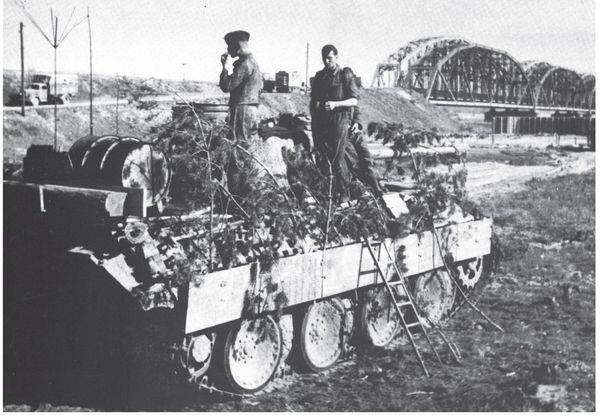Warszawa II (20 page)
Authors: Norbert Bacyk

At that time the Polish forces were attached to General Kuzmin's 125th Rifle Corps. On September 9, 1944, the 1st Tadeusz KoÅciszko-Infantry Division counted a total of 8,893 soldiers and had at its disposal 102 8.2 to 12 cm, mortars, 37 4.5 cm. anti-tank guns, 36 7.62 cm. guns, 12 12.2 cm. howitzers and 13 assault-guns, model SU-76M, plus 244 vehicles and 1,193 horses. Direct support was provided by the Soviet 13th Light Artillery Brigade, the 23rd Rocket Artillery Brigade, the 30th Heavy Artillery Brigade, the 100th Howitzer Brigade, the 139th Engineer Battalion, the 58th Guards Tank Brigade's 2nd Battalion (support provided by the Soviet units). Initially, the division only sent selected infantry battalions into combat. As it happened, the Poles opposition in the Anin-area was an infantry battalion from the 73rd Infantry Division's Infantry-Regiment 70 supported by a battery of 12 cm mortars (incidentally, it can be noted that the German 12 cm mortars, model sGrWr 42, were an identical copy of the mortars used by the Red Army). Longer out on 1st Infantry Division's attacking shoulder, Artillery-Regiment 173 from the 73rd Infantry-Division was also deployed on the front.
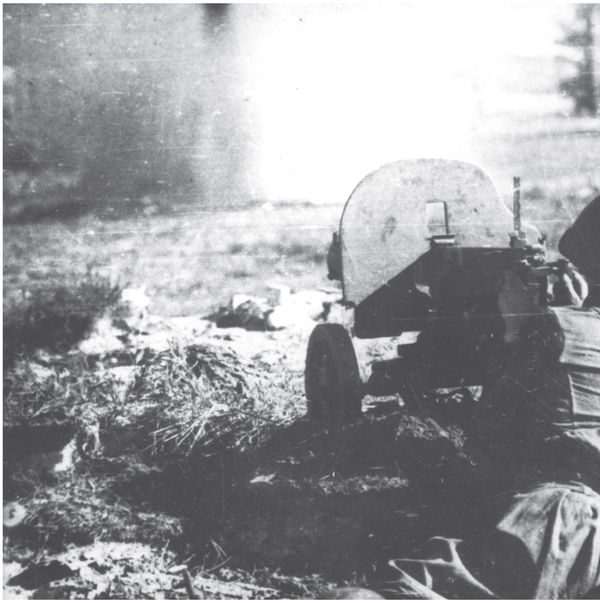
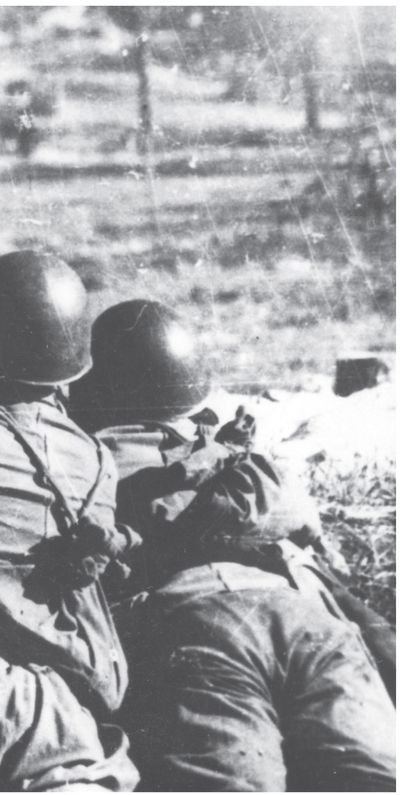
A Polish Maksim machinegun (model 1910) in position in September of 1944. (WAF)
At 10:00 AM, September 10, after a one-and-a-half hour artillery barrage, the 114th Rifle Corps had the honour of being the first unit to open the attack. Once again, intensive fighting broke out at SÅupno and at the entry points to the Nieporet-Forest. Troops from the 3rd SS-Panzer-Division “Totenkopf” and the 5th SS-Panzer-Division “Wiking” threw back all enemy infantry attacks, inflicting heavy losses in the process. The vicinity of height no. 104 marked the first incident that took place with consequences that would have dramatic repercussions on both sides: One of the 160th Rifle Division's regiments, supported by a tank company, fought through the deadly fields of fire and passed the German lines and, when they reached the forest's main road, set off towards nearby StanisÅawów. But when the next wave of Soviet infantry and tanks began to attack the defending force from the direction of SÅupno, StuG 40 assault-guns from the 3rd SS-Panzer-Division “Totenkopf” suddenly cropped up near height no.104 and forced the enemy to retreat under massive bombardment. In this way, the lead regiment, which toward evening had been decimated to 150 soldiers and 6 tanks, were separated by the 3rd SS-Panzer-Division “Totenkopf's” detached rearguard. They fought relentlessly outside StanisÅawów â but before dark, the SS- troops had brought them to their knees. At the same time, the main infantry forces from the 114th Rifle Corps had become bogged down in the ruins of the villages of Sieraków and SÅupnos.
Events worked out much better for the main forces of the 47th Army. Their attack commenced at 1300 hours along the WisÅa, opening with only the 175th Rifle Division. The German, 73rd Infantry-Division met this first attack with violent counterattacks. Soon, however, the entire 125th Rifle Corps joined in the fighting. Thanks to their numerical superiority, which also applied to artillery an anti-aircraft gun support, they eventually were able to crush the enemy's resistance. The German infantry began to withdraw towards the north. The commander of the 73rd Infantry-Division, Colonel Kurt Hählig, was wounded and lost command of his unit. And though individual battalions attempted to carry out counterattacks â for example, the 76th Rifle Division had, in fact, been beaten back from Stara MiÅosna - nevertheless, before the clock reached 1600 hours, the Germans were forced to retire from Anin (godsen Zastów and Sadul). Towards evening,
Polish and Soviet infantry began to approach the buildings of Praga's suburb, Wawer, by fighting their way through on the right-hand side of the railway tracks.
The knowledge that the attack on Praga had now begun forced the commands of the 9th and 2nd Armies to alter their operational plans. The decision to begin attacking the bridgehead at PuÅtusk was now conditioned on how the attack outside Warsaw went. General von Vormann halted the march of the 19th Panzer-Division towards Modlin and turned it, instead, directly towards Praga. Panzergrenadier-Regiment 73 and SS-Panzer-Regiment 5 “Wiking”, which were also part of the panzer division's complement and had thus far been fighting outside PuÅtusk, were also commandeered in preparation for battle against Warsaw.
On September 11, tanks from the 19th Panzer-Division rolled into Praga. General Källner, who commanded the division, had been assigned the split 73rd Infantry-Division and gave them the order to halt the enemy attacks. The Germans organised a series of counterattacks. Since the panzer divisions had begun to participate in the fighting successively, the commander had only succeeded in stopping the 125th Rifle Corps' advance, which as of September 11 had been supported by tanks from the 8th Guards Tank Corps' tank brigades. That same day, the Soviet formation occupied the city sectors of Wawer, Rembertów and the village of Zielonka. Only during the attack against Grochów, a typical built-up urban area, were they driven back. In addition, the 77th Rifle Division's infantry was activated and applied hard pressure against the 1st Calvary's Hungarian positions in the woods north of Rembertów.
In the 3rd SS. Panzer-Division “Totenkopf 's” area, the 114th Rifle Corps â with support from the 129th Rifle Corps' 328th Rifle Division â continued fighting. On September 11, the infantry, supported by tanks, again sped towards the NiÄporet-Forest. The Soviet units fought their way into the woods taking significant losses under close-combat conditions. The panzer-grenadiers and the Soviet infantry continued to fight on with determination but at the end of the day neither side had succeeded in forcing the other from the wooded area.
On September 12, the 73rd Infantry-Division's line of defence was broken despite tank support from Panzer-Regiment 27. The German infantry troops fled in panic towards the town. On the road between Anin and Wawer (along the Otwock line) the Polish 1st Infantry Division destroyed the German Artillery-Regiment 173. The only troops left at the German defensive positions were panzer-grenadiers from the 19th Panzer-Division, but due to their meagre number (in the combat companies of both regiments' four battalions at that time, there were barely 900 soldiers â but Polish records report that only Panzergrenadier-Regiment 74 participated in the fighting), the Poles were able to hold a broad front. An irritated von Vormann wrote that
“the opposition's attack has completely broken through the 73rd Infantry Division's front [â¦] during the course of two days fighting the division has not shown any fighting spirit whatsoever, and therefore cannot be said to possess any combat value worthy of mention.”
The Hungarian soldiers also withdrew from Rembertów in the direction of Zielonka. The 77th Rifle Corps, which followed in their tracks, received support from tanks of the 8th Guards Tank Corps.. General Gusiev, however, had no intention of letting his tank corps get bogged down in street fighting â he only intended them to be used in attacking the city's suburbs from the flanks. Despite this, individual tank battalions remained in order to support the 125th Rifle Corps.
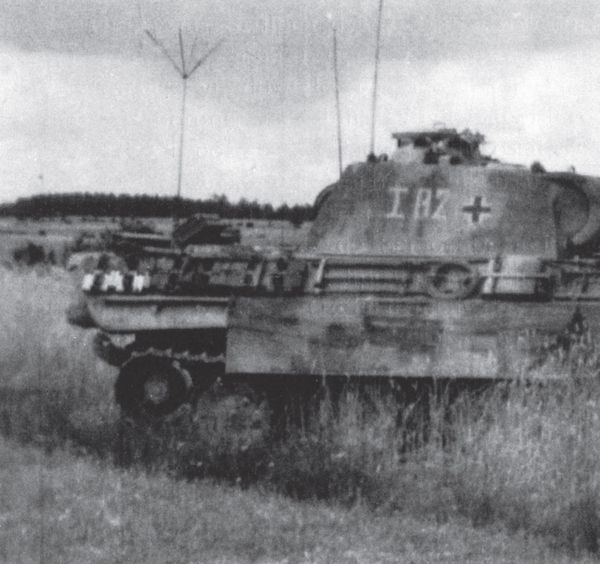
A Panther Sd Kfz from HK-Kompaniet from I/SS-Panzer-Regiment 5. Note the ID no. I02 on the turret which has another camofluage pattern elsewhere in the book. (Leandoer & Ekholm archive)
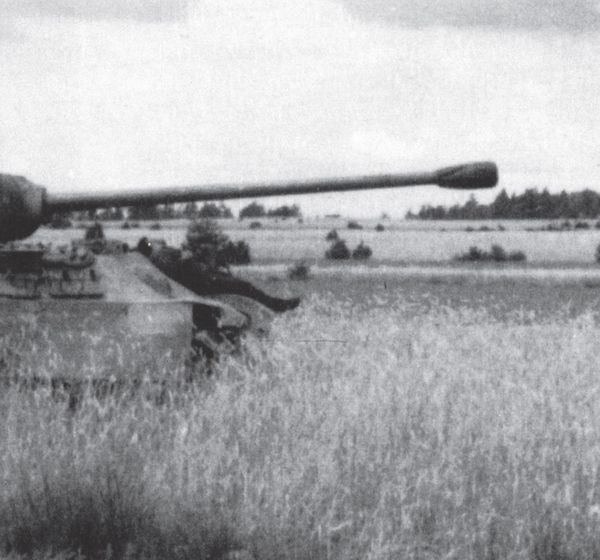
Towards evening, the 175th Rifle Division moved over towards GocÅaw, while the 1st Infantry Division and the 76th Rifle Division made a northerly detour around the effective defences at Grochów, taking KawÄczyn and closed in on the built up communities of Utrata, Elsnerów and ZÄ
bki. On or about the same time this was taking place, 1640 hours to be precise, Captain KapuÅciÅski from the 1st Infantry Regiment entered Praga's centre. General Källner carried out several counter-attacks, with the support of tanks, near the city sector Saska KÄpa in Targówek: On September 12, in the Polish sector alone, eight such attacks were carried out. But these were thrown back by the 175th Rifle Division's artillery and the Polish 1st Infantry Division (for defensive purposes, using the 1st Light Artillery Regiment's direct-target guns). Now the Germans, together with the Hungarian 1st Cavalry Division, tried to organise a new defensive line along the Zielonka â ZÄ
bki â Elsnerów railway. The 19th Panzer-Division carried out a defensive manoeuvre. The commander of the 1st Infantry Division reported that the enemy operated in formations of 8 â 14 tanks supported by one or two infantry companies. What was particularly amazing was that they had identified the “Elephants” company, but naturally the whole business turned out to be a misunderstanding. On the German side, the only success experienced on September 12 was the 3rd SS-Panzer-Division “Totenkopf's” effective counterattack, which had taken place in the forest near SÅupno. Following on a violent grenadier assault supported by tank artillery, the 144th Rifle Corps was driven out of the NiÄporet-Forest.
The command vehicle, PzBfWg V Sd Kfz 267 “Panther,” from II SS-Panzer-bRegiment 5 “Wiking” by the bridge across the WisÅa in KazuÅ, probably in Septemer 1944.
